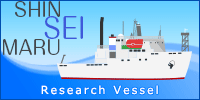The research program comprises 4 projects, which consist of 10 themes in all. Projects 1 to 3 will promote investigation and research and Project 4 will construct a base for sending out information conducive to the reconstruction of industries in the disaster-affected areas.
With the aim of clarifying variation in the mechanisms of anthropogenic production and the environment of the fishery grounds, we will identify changes to the environment of the fishery grounds caused by the Great East Japan Earthquake by studying the ecology of the coastal fishery grounds, including marine culture farms. We will also carry out a follow-up survey on changes in marine ecosystems during the reconstruction process of the industries in the coastal region damaged during the disaster. The research will be performed mainly in Onagawa Bay and Sendai Bay.

1
- Environmental monitoring in coastal sea areas of Miyagi Prefecture
-
Although there have been many fishery grounds and aquaculture farms in the coastal region of
Miyagi Prefecture, the environments may have changed as a result of the earthquake and tsunami. We
will continuously observe oceanic conditions in the fishery grounds and aquaculture farms using
marine observation buoys, and we will continually collect environmental data, including water
quality, bottom material, and organisms, using research vessels.
Providing fishermen with useful information, we will track the flow of matter in marine ecosystems and we will clarify the restoration of the environments within the fishery grounds and aquaculture farms.
2
- Ecosystems and genetic researches to conserve and restore the coastal fisheries areas in Miyagi Prefecture
- The tsunami and land subsidence caused by the massive earthquake brought about a considerable change in the Sanriku coastal areas, which had been one of the richest fishery grounds in the world. Researchers in ecology, genetics, and molecular biology will cooperate to monitor changes in various organisms and the surrounding environments in the long-term and will clarify the restoration of the coastal ecosystems.
3
- Research on the coastal fisheries resources and the tidal flat faunas off Miyagi Prefecture
- Tidal flats, sandy beaches, and shallow sea areas were severely disturbed by the massive tsunami and, in addition, the topographic features were changed and debris remains there. Both organisms and fishermen have to respond to such large environmental change. We will continue to study the dynamics of fauna and the distribution of the bioresources.
4
- Aquaculture environment in the coastal water of Miyagi Prefecture and innovation of aquaculture system
- The tsunami caused by the giant earthquake devastated aquaculture facilities along the Sanriku coast. Aquaculture facilities themselves have been gradually restored. However, the impact on the environment of the aquaculture grounds, including water quality and coexisting life, is expected to last for a significant period of time. We will investigate the change in the environment from the viewpoint of chemical pollution, the progress of aquaculture production, and study the way aquaculture responds to the changes.
5
- Studies on the coastal environment and marine resources in the southern part of Iwate Prefecture
- By undertaking long-term studies of the marine environments and aquaculture environments in the beautiful sea off Sanriku, in particular some of the bays along the ria coast of the southern part of Iwate Prefecture, we will reveal characteristics of these areas from the viewpoint of water quality and the ecological characteristics of aquatic animals and plants in these areas. These studies will reveal the impact of the Great East Japan Earthquake on this area and will contribute to the development of new fisheries that incorporates scientific data.
We will comprehensively assess the influence of the earthquake and tsunami on the coastal marine ecosystems and the physical and chemical environments, and we will elucidate factors controlling these marine ecosystems and environments. On the basis of the data collected, we will construct a numerical model of the coastal marine ecosystems to provide scientific findings on the variation in ecosystems and environments, which will support reconstruction of the fisheries. We will investigate the coasts of Otsuchi and the northern part of Iwate Prefecture and we will also perform comprehensive observations and research from the coasts to the offing using research vessels.

1
- Monitoring system for the coastal region and Marine Analysis Center
- We will make a system to constantly monitor the marine environment in Otsuchi Bay and the surrounding sea, and we will compile the data in real time and also establish a center to analyze samples obtained by the research program using highly sensitive, uniform methods.
2
- Study on the disruption, and subsequent recovery process, of the ecosystems from the earthquake and tsunami
- The earthquake and tsunami caused disruption to the marine ecosystems at various scales dependent on the degree of the disaster and the coastal landforms, and also exerted various impacts on the biotic communities in terms of the distribution, habits, and behavior patterns. We will bring together the knowledge of many specialists in different fields to reveal the impacts of the earthquake and tsunami and detail the restoration process through continuous studies.
3
- Study of changes to the material circulation process following the earthquake
- The continuous supply of nutritive salts to the Sanriku coastal areas has supported food chains, starting with phytoplankton, and has brought plentiful marine products. Changes in the terrain of the land and coasts, and the accompanying change in fresh water flow patterns and ocean currents, caused by the earthquake and tsunami, appear to have affected the nutrient supply processes and food chain structure. Through detailed analysis of such impacts, we will clarify the mechanisms required to maintain and restore these fishery resources.
4
- Elucidation of the actual situation and impact of land-based pollutant inflow
- Devastation of cities and towns by the earthquake and tsunami may have changed the quantity and quality of substances flowing from land to sea. In addition, some buildings swept away by the tsunami may have stayed at the bottom of the coastal region and may have discharged synthetic substances gradually. We will clarify the presence and behavior of such substances (potential environmental pollutants) using sensitive detection technologies.
5
- Construction of an ecosystem model integrating physical processes
-
The sea surrounding Otsuchi Bay, located in the northwest Pacific ocean, is a place where the
Tsugaru warm water current, the Oyashio (Kuril Current), and the Kuroshio (Japan Current) are
complicatedly intermingled with each other.
Flows of these currents greatly affect the agitation and transportation of chemical substances and biological processes. Accordingly, we will examine these ocean current flows and will integrate the results with biological information to construct an ecosystem model.
FY2015
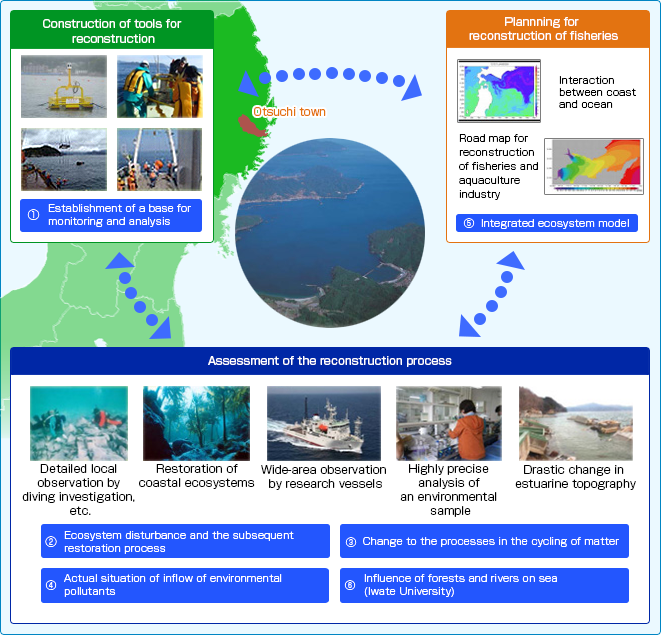
1
- Monitoring system for the coastal region and Marine Analysis Center
- We will make a system to constantly monitor the marine environment in Otsuchi Bay and the surrounding sea, and we will compile the data in real time and also establish a center to analyze samples obtained by the research program using highly sensitive, uniform methods.
2
- Study on the disruption, and subsequent recovery process, of the ecosystems from the earthquake and tsunami
- The earthquake and tsunami caused disruption to the marine ecosystems at various scales dependent on the degree of the disaster and the coastal landforms, and also exerted various impacts on the biotic communities in terms of the distribution, habits, and behavior patterns. We will bring together the knowledge of many specialists in different fields to reveal the impacts of the earthquake and tsunami and detail the restoration process through continuous studies.
3
- Study of changes to the material circulation process following the earthquake
- The continuous supply of nutritive salts to the Sanriku coastal areas has supported food chains, starting with phytoplankton, and has brought plentiful marine products. Changes in the terrain of the land and coasts, and the accompanying change in fresh water flow patterns and ocean currents, caused by the earthquake and tsunami, appear to have affected the nutrient supply processes and food chain structure. Through detailed analysis of such impacts, we will clarify the mechanisms required to maintain and restore these fishery resources.
4
- Elucidation of the actual situation and impact of land-based pollutant inflow
- Devastation of cities and towns by the earthquake and tsunami may have changed the quantity and quality of substances flowing from land to sea. In addition, some buildings swept away by the tsunami may have stayed at the bottom of the coastal region and may have discharged synthetic substances gradually. We will clarify the presence and behavior of such substances (potential environmental pollutants) using sensitive detection technologies.
5
- Construction of an ecosystem model integrating physical processes
-
The sea surrounding Otsuchi Bay, located in the northwest Pacific ocean, is a place where the
Tsugaru warm water current, the Oyashio (Kuril Current), and the Kuroshio (Japan Current) are
complicatedly intermingled with each other.
Flows of these currents greatly affect the agitation and transportation of chemical substances and biological processes. Accordingly, we will examine these ocean current flows and will integrate the results with biological information to construct an ecosystem model.
6
- Analyses of the chemical dynamics in the water catchment areas, rivers, estuaries, and coastal waters
- Land-derived chemical substances flowing into the coastal areas not only support the primary production of plants in the coastal areas but also affect biological processes there. The influence varies according to the characteristics of the terrestrial ecosystems and streams. We will elucidate the influence of rivers on coastal ecosystems through basic surveys of rivers in the Sanriku coastal areas.
FY2011 - FY2014
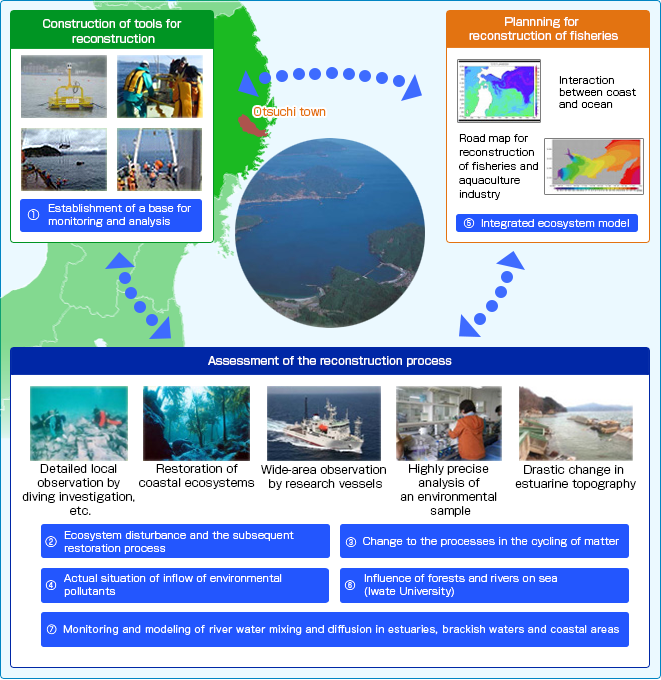
1
- Monitoring system for the coastal region and Marine Analysis Center
- We will make a system to constantly monitor the marine environment in Otsuchi Bay and the surrounding sea, and we will compile the data in real time and also establish a center to analyze samples obtained by the research program using highly sensitive, uniform methods.
2
- Study on the disruption, and subsequent recovery process, of the ecosystems from the earthquake and tsunami
- The earthquake and tsunami caused disruption to the marine ecosystems at various scales dependent on the degree of the disaster and the coastal landforms, and also exerted various impacts on the biotic communities in terms of the distribution, habits, and behavior patterns. We will bring together the knowledge of many specialists in different fields to reveal the impacts of the earthquake and tsunami and detail the restoration process through continuous studies.
3
- Study of changes to the material circulation process following the earthquake
- The continuous supply of nutritive salts to the Sanriku coastal areas has supported food chains, starting with phytoplankton, and has brought plentiful marine products. Changes in the terrain of the land and coasts, and the accompanying change in fresh water flow patterns and ocean currents, caused by the earthquake and tsunami, appear to have affected the nutrient supply processes and food chain structure. Through detailed analysis of such impacts, we will clarify the mechanisms required to maintain and restore these fishery resources.
4
- Elucidation of the actual situation and impact of land-based pollutant inflow
- Devastation of cities and towns by the earthquake and tsunami may have changed the quantity and quality of substances flowing from land to sea. In addition, some buildings swept away by the tsunami may have stayed at the bottom of the coastal region and may have discharged synthetic substances gradually. We will clarify the presence and behavior of such substances (potential environmental pollutants) using sensitive detection technologies.
5
- Construction of an ecosystem model integrating physical processes
-
The sea surrounding Otsuchi Bay, located in the northwest Pacific ocean, is a place where the
Tsugaru warm water current, the Oyashio (Kuril Current), and the Kuroshio (Japan Current) are
complicatedly intermingled with each other.
Flows of these currents greatly affect the agitation and transportation of chemical substances and biological processes. Accordingly, we will examine these ocean current flows and will integrate the results with biological information to construct an ecosystem model.
6
- Analyses of the chemical dynamics in the water catchment areas, rivers, estuaries, and coastal waters
- Land-derived chemical substances flowing into the coastal areas not only support the primary production of plants in the coastal areas but also affect biological processes there. The influence varies according to the characteristics of the terrestrial ecosystems and streams. We will elucidate the influence of rivers on coastal ecosystems through basic surveys of rivers in the Sanriku coastal areas.
7
- Monitoring and modeling of river water mixing and diffusion in estuaries, brackish waters and coastal areas
- Being influenced by the flow, temperature, and topography of estuarine areas and the sea floor, river water gradually mixes with seawater and flows out to sea. Accurate estimation of the river water mixing and diffusion is important in estimating the behavior of chemical substances in bays and their contribution to biological production. We will clarify and model the physical processes using original monitoring equipment..
In this project study, we dealt with the following research to contribute to fishery reconstruction with a scientific viewpoint mainly in offshore areas on the sea floor of Miyagi from Iwate.
- - To clarify the marine state of biological communities, environmental conditions, and fluctuation.
- - The debris which flowed into the ocean after the huge tsunami and to assess its influence on the marine ecosystem.
From 2016 we will be applying data to ecosystem models, and visualize marine organisms and environmental fluctuations along the Sanriku coast. Provide scientific knowledge to contribute to reconstruction of sustainable fisheries and utilization of coastal waters.

FY2014 - FY2015
To understand actual conditions and variations in bioresources and environments in offshore submarine fishery grounds, we will perform debris mapping and elucidation of the process of debris decomposition; long-term monitoring of bioresource environments; examination of the distribution, behavior, and population structure of biological resources; and analysis of bioaccumulation of chemical substances in marine organisms. Through these studies, we will contribute to the restoration of fisheries. For this purpose, we will obtain three-dimensional data by making full use of an untethered remotely operated vehicle (UROV), side-scan sonar, bio-tracking system, and trophic level analysis. We will also conduct habitat mapping to organize data that will be conducive to the management of the ecosystems.
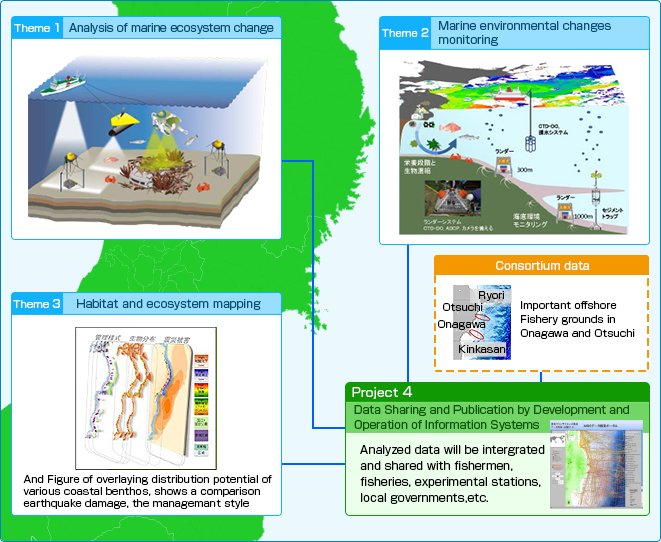
1
- Analysis of marine ecosystem change
- Deep-sea ecosystems off Tohoku were damaged by "the 2011 off the Pacific coast of Tohoku Earthquake". For understanding of the influences and recovery processes from the damage, distribution patterns and biomass of fishery resources are studied in relation to marine tsunami debris. We also analyze the influences of anthropogenic disturbance on offshore fishing grounds. A bio-tracking system will be developed and applied for understanding of ecology and behavior of fishery resources in the deep sea. Acoustic exploration is underway for topographic mapping and sub-bottom profiling in this region. Finally, these efforts will contribute to management of fishery resources and the development.
2
- Marine environmental changes monitoring
-
In the sea off Sanriku, the topography and the conditions of the surface layer of the seafloor
have changed due to earthquake-related factors, such as inflow of soils from the coastal region,
and the marine biological resources have been affected. We will observe continuously the seafloor
and surrounding environments with automatic observation equipment and others to sport the fishery
in the Tohoku.
We will also elucidate the distribution of a toxic substance, polychlorinated biphenyl (PCB), in sediments and fishes, and clarify the process in which PCB is gradually accumulated through food chains.
3
- Habitat and ecosystem mapping
- Habitat and ecosystem mapping unit in TEAMS aims to integrate data from our project and aims to show the situation of the ecosystems using maps. Creation of the habitat maps are expected to be used for understanding of the effects of great tsunami, showing the state of marine biodiversity and identification of the important area for ecosystem resilience.
FY2011 - FY2013
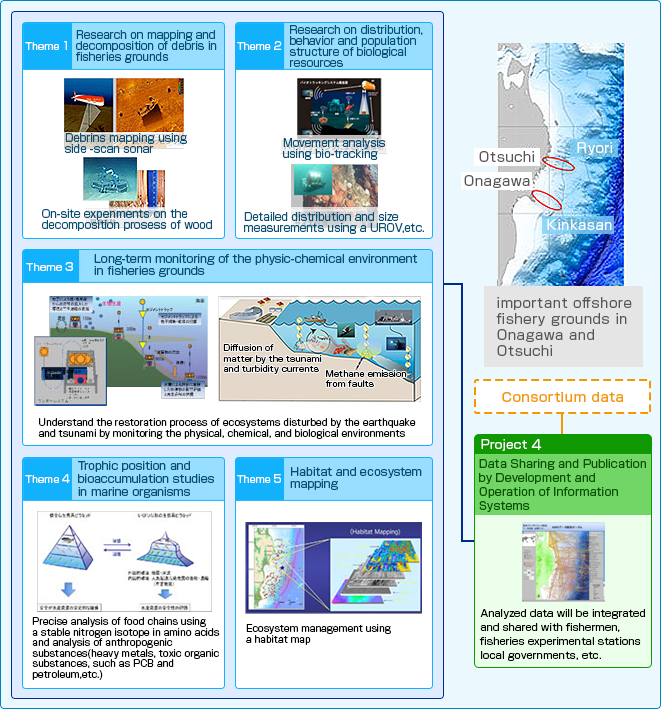
1
- Research on mapping and decomposition of debris in fisheries grounds
- Debris that was swept away by the massive tsunami and has remained on the seafloor has greatly affected submarine ecosystems and fisheries. To comprehensively assess the impact of debris on local fisheries and marine ecosystems, we will conduct mapping of debris scattered on the seafloor by obtaining submarine topographic information in detail, and we will clarify how debris are decomposed through experiments in situ.
2
- Research on distribution, behavior and population structure of biological resources
- The earthquake and tsunami may have affected benthic organisms in the offshore areas. In this theme, we will analyze the distribution and population of aquatic organisms through detailed observations in situ. We will also develop a technique to monitor the movements of organisms in the deep sea by attaching a device that emits acoustic waves to organisms. Through this research, we will contribute to sustainable fisheries.
3
- Long-term monitoring of the physic-chemical environment in fisheries grounds
- In the sea off Sanriku, the topography and the conditions of the surface layer of the seafloor have changed due to earthquake-related factors, such as inflow of soils from the coastal areas, and bioresources in the offing have also been affected. We will monitor the seafloor and surrounding environments with automatic observation equipment to accumulate findings about marine bioresources.
4
- Trophic position and bioaccumulation studies in marine organisms
- We will elucidate the distribution of a toxic substance, polychlorinated biphenyl (PCB), in sediments and fishes collected in the sea off Tohoku, and we will also clarify the process in which PCB is gradually accumulated through food chains.
5
- Habitat and ecosystem mapping
- With the aim of evaluating the actual state of, and the variation trends in, post-disaster marine environments and ecosystems, we will use a geographic information system (GIS) to integrate observation data from marine environments, seafloor topography, bottom material, organisms, disaster rubble, etc. We will analyze correlations and variations in the elements of the target marine ecosystems on the basis of a habitat map.
We will construct an open database through which data obtained by the research program can be integrated and shared with all people, foreign and domestic, and we will organize basic data so that it is conducive to resource management. The database will provide scientific information in an easy-to-understand format to local governments and fishermen in the disaster-affected areas, including information on ecosystem variation and environmental predictions, and basic data for effective and efficient fisheries.

Links




